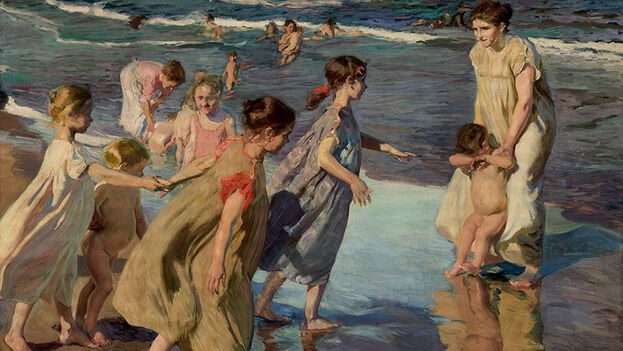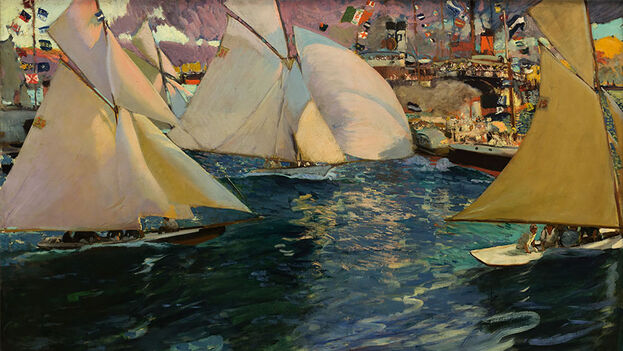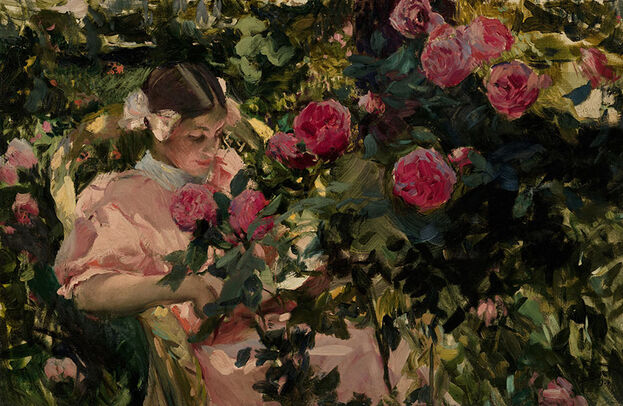
![]() 14ymedio, Xavier Carbonell, Salamanca, 14 April 2023 – After arduous negotiations with the government in Valencia over a period of seven years, Havana has given its reply: the paintings of Joaquín Sorolla, currently in the custody of the city’s Museum of Fine Art, and whose journey to Spain for the centenary of the death of the artist had been anticipated, will remain in Cuba. The rebuff was to be expected. This is all about a country which is troubled by numerous debts and murky deals, and which robbed from its legitimate owners almost all of the art kept in its galleries, and whose regime doesn’t want to risk another fight on the battlefield of international law.
14ymedio, Xavier Carbonell, Salamanca, 14 April 2023 – After arduous negotiations with the government in Valencia over a period of seven years, Havana has given its reply: the paintings of Joaquín Sorolla, currently in the custody of the city’s Museum of Fine Art, and whose journey to Spain for the centenary of the death of the artist had been anticipated, will remain in Cuba. The rebuff was to be expected. This is all about a country which is troubled by numerous debts and murky deals, and which robbed from its legitimate owners almost all of the art kept in its galleries, and whose regime doesn’t want to risk another fight on the battlefield of international law.
Valencia, for its part, has had to give up its fight. Carmen Amoraga, director general of Culture and Heritage in the Generalitat, announced publicly that the Cuban government had decided to suspend the loan, saying that the “international situation” wasn’t favourable.
Upon contacting Amoraga’s office directly, the response – “on the instructions of the director general” – was even more terse: “We do not have any information on this issue”. There was silence also from the other side of the Atlantic, where requests for an explanation from curators and experts in Havana fell on deaf ears.
Finally, a collector of Cuban origin, well informed on matters of Sorolla’s works, diagnosed the problem: “No one at the museum will dare to talk, because their specialists don’t have any control over international art loans. That decision was taken in higher circles, between the Ministry of Culture and the Chancellery. The reason for the silence on both sides is simple: they want to to avoid a scandal, bad press and other complications”.
In 2016, a delegation of Valencian business owners, headed by the president of the autonomous community, Ximo Puig, travelled to Havana. The political atmosphere was tense but very promising. Fidel Castro, in terminal decline, would die one month after this visit. His brother Raúl appeared to be open to an economic opportunity and had begun a process of thawing diplomatic tensions between Cuba and the United States. And Eusebio Leal, the frenzied Havana Historiographer – and quick-witted manager – had brought relations with Spain to their most positive level.
Puig returned to the Iberian Peninsular in a state of ease. As well as achieving his commercial agenda, his Havana business counterparts had – amongst all the cigar gift-boxes and meetings dressed in light guayabera shirt-jackets – esteemed it perfectly fine to hand over some thirty Sorolla paintings, along with other works by Valencian artists such as Mariano Benlliure and Julio Vila Prades. Once the loan of the works was secured, Spain would agree to clean and restore them, as well as bear the cost of their transport from the Island.

The plan was to surpass even the 1985 exhibition, to which Fidel Castro, as secure then in power as ever, had given consent: The Havana Sorollas, which had been held over one month in Madrid and another month in Valencia.
In 2019, it was Carmen Amoraga who went to the Cuban capital. It was the city’s 500th anniversary. Eusebio Leal, very ill, was in his last days, and Miguel Díaz-Canel was now the visible pompous-jerk president, appointed from the invisible powers above him – a dependent of the Castro dynasty clan. Inside of only three years, the rules of the game had changed. After a review of the condition of the paintings, Amoraga didn’t manage to seal an agreement with the Cuban government, but everything did appear to indicate that the works would be making their way to Spain in 2023, in time for the anniversary.
However, now there wouldn’t be thirty paintings, but only ten. Some of the others, she explained, were subject to dispute and couldn’t leave Cuba. On top of that, all those works by other Valencian masters had been kept out of the discussion.
The whole business was made worse by the 2020 pandemic. And following that, the Havana regime was overtaken by profound crisis – underlined by the huge protests of 11 July 2021 and then the emerging international disgrace of its alliance with the Kremlin and its support for Putin’s criminal invasion of Ukraine. But the most suffocating dimension of the country’s problems was that of the multi-million dollar outstanding payments accumulated by Castro after several decades of subterfuge in trying to evade the creditors.
At the High Courts of Justice in London in February, the investment firm CRF I claimed a debt of 72 million Euros from the National Bank of Cuba. Faced with a possible ruling against it – which did then come to pass on 4 April when the British court partially ruled in favour of the creditor – Havana decided not to go ahead with the loan of the Sorollas: most of them illegally confiscated after 1959 by Castro. This, then, is the “international situation” that, according to Amoraga, ruined the Valencian government’s celebrations.
It’s thought that Cuba holds the third most important collection of Sorollas in the world, after those of Spain and New York. Collectors, millionaires and cultural institutions were acquiring his works from 1923 onwards, sometimes directly from the artist himself. At the Universal Art building of the Cuban museum – an impressive manor house located on Paseo del Prado in Havana – one can admire Pescadores Valencianos (Valencian Fishermen, 1908), Haciendose a la mar (Going to the Seaside, 1908), or Verano (Summer, 1904) – this latter one perhaps the most valuable of Sorolla’s works on the Island, and, doubtlessly, the one most ingrained in the visual memory of Cubans.
Around 1950, almost all of the Sorollas in Cuba were owned by sugar magnates – the Lobo, the Cintas and the Fanjul Gómez-Mena families, whose names don’t appear in the Havana catalogues. Nor is there any talk of their theft – dressed up as a transfer to the socialist state – which the Ministry for the Recuperation of Embezzled Goods brought to a head after the triumph of the Revolution.

The Fanjuls, connected via marriage to the Gómez-Menas – who went into exile in the United States and rebuilt their fortune there – had hidden a number of paintings behind a wall, constructed expressly for the purpose in their mansion in El Vedado. The revolutionary government converted the building into the Museum of Decorative Arts and seized all its master works, including those that were hidden. Many were auctioned at prestigious auction houses, such as the British Sotheby’s, or ended up in the hands of officials and associates of Castro.
When, at the end of the nineties, the impresario José Fanjul discovered that Puerto de Málaga (The Port of Málaga, 1910) – one of his family’s Sorollas – had been sold in London, he put together a team to find out who the buyer was. Sotheby’s washed their hands of it and tried to exit gracefully from the investigation but the alarm was raised in Havana. The Fanjuls, worried that Castro would sell all the works confiscated from the family in order to help him get out of the economic tight spot which the fall of the Soviet Union had put him in, set about making international demands for stopping the trafficking of art organised from the Island. The Cintas’ foundation had done the same thing in 1995 when they found out that two of the Cuban magnate Óscar Cintas’s Sorollas were on sale at Sotheby’s.
The former legitimate owners of the pictures brought to light an intricate network of dealers, peddlers, curators, spies and agents of the regime. In 2009 when Havana discretely loaned two Sorollas to the Prado Museum – one of them being Verano – the Fanjuls once again launched a judicial challenge. Protected by the Helms-Burton law, which penalises the traffic of goods expropriated by Castro, they sued the the museum. However, they couldn’t get the pictures back.
The intransigence of Fidel’s political heirs, the rupture of power in anticipation of the death of Raúl Castro (who will be 92 this June), and the debacle of the national economy, have all put off even further the happy ending which the Valencian authorities had been hoping for since 2016. With these precedents, and the high profile media attention on the ‘Year of Sorolla’, it’s unlikely that the painter will be able to avoid his being hijacked by Havana.
Translated by Ricardo Recluso
____________
COLLABORATE WITH OUR WORK: The 14ymedio team is committed to practicing serious journalism that reflects Cuba’s reality in all its depth. Thank you for joining us on this long journey. We invite you to continue supporting us by becoming a member of 14ymedio now. Together we can continue transforming journalism in Cuba.
